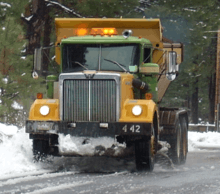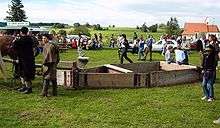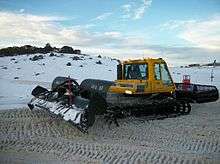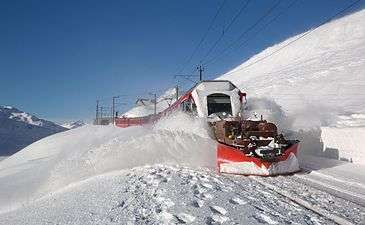Snowplow

- For the skiing turn, see snowplough turn.
A snowplow (also spelled snow plow, snowplough or snow plough, see miscellaneous spelling differences) is a device intended for mounting on a vehicle, used for removing snow and ice from outdoor surfaces, typically those serving transportation purposes. Although this term is often used to refer to vehicles mounting such devices, more accurately they are known as winter service vehicles, especially in areas that regularly receive large amounts of snow every year, or in specific environments such as airfields. In other cases, pickup trucks and front end loaders are outfitted with attachments to fulfill this purpose. Some regions that do not frequently see snow may use graders and other equipment for this task, but graders are nonetheless the best equipment to remove compacted snow and ice off the streets. Snowplows can also be mounted on rail cars to clear railway tracks.
Usage


A snowplow works by using a blade to push snow to the side or straight ahead, clearing it from a surface. Modern plows may include a great deal of technology to make the job—and staying on the road—easier, such as Global Positioning System receivers, head-up displays and infrared cameras.
Large custom snowplows are commonly used at major airports in North America. These plows have oversized blades and additional equipment like a rotating sweeper broom (sometimes called jetblade) and blowers at the rear of the plow.
For sidewalks and narrow laneways small tractor plows (tracked or wheeled) are used in Canada and the United States.
When snowfalls accumulate above a certain height, snowplow operators may be seen clearing primarily designated "snow routes", often for the exclusive use of emergency vehicles such as fire trucks.
Underbody scrapers are sometimes mounted on vehicles in residential and urban settings, operating on principles similar to a road grader, but allowing greater weights and speed along with the carriage of a road treatment applicator.
Newer technology has allowed the use of articulated plow systems which can clear multiple divided highway lanes simultaneously; jurisdictions adopting this technology include the provinces of Alberta, British Columbia, New Brunswick, Ontario and Quebec in Canada,[1] along with 15 states (Indiana, Kansas, Maine, Massachusetts, Michigan, Minnesota, Missouri, New York, North Dakota, Ohio, Pennsylvania, Tennessee, Utah and Wisconsin) in the US.[2][3][4]
History


The first snow plows were horsedrawn wedge-plows made of wood. With the advent of the automobile, a number of inventors set about to improve existing snow plows. In the US, the "snow-clearer" is said to have been patented as early as the 1840s,[5] for railways. The first snow plow ever built specifically for use with motor equipment was in 1913. It was manufactured by Good Roads Machinery in Kennett Square, PA. and was designed to meet the exacting requirements outlined by engineers of the New York City Street Cleaning Bureau.[6] Good Roads is therefore unofficially credited as the originator of the modern snow plow, though their horse drawn steel blade road graders were used to clear roads of snow as early as the company's founding in 1878 under their original name American Road Machinery.[7] Good Roads patented the first four-wheel grader in 1889 thus making it the first pull grading apparatus patented in the United States.[8] Unlike most early snow plow manufacturers, Good Roads continues to manufacture snow removal equipment today under the name Good Roads Godwin, now located in Dunn, North Carolina. In the early 1920s Good Roads often advertised in The American City magazine that "...three out of every four snow plows in use throughout the whole United States are Good Roads Champions." By the mid-1920s Good Roads was manufacturing snow plows of various shapes and sizes for use on a wide variety of motorized equipment. Other snow plow manufactures began to follow suit as motorized plows were proven more efficient than other methods of snow removal.
In 1923, the brothers Hans and Even Øveraasen of Norway constructed an early snowplow for use on cars. This proved to be the start of a tradition in snow-clearing equipment for roads, railways[9][10] and airports, as well as the foundation of the company Øveraasen Snow Removal Systems. Carl Frink of Clayton, New York, USA was also an early manufacturer of automobile-mounted snowplows. His company, Frink Snowplows, now Frink-America, was founded by some accounts as early as 1920.[11]
Today snow plows are produced by numerous companies around the world and available for different kinds of vehicles such as service trucks, pickup trucks, SUVs and ATVs. They are installed using model specific or universal hardware and mount to the frame of the vehicle to ensure durable connection. There are manual, power and hydraulic operating snow plows. All necessary mounting hardware usually comes in set with a plow. Snow plow blades are available in various sizes depending on a vehicle type. Service trucks usually use a blade sized 96 in (2.4 m) and more. Common blade size for pickup trucks and full size SUVs is 78–96 in (2.0–2.4 m). Smaller ATV snow plow blades are 48–78 in (1.2–2.0 m) wide.
Railway snowplows
.jpg)
In many countries, railway locomotives have small snowplows permanently attached to their bogies, which also serve as pilots. With others, the snowplow forms part of the obstacle deflector below the bufferbeam. Bolt-on versions also exist, and these attach to the bufferbeam or front coupler. However, larger snowplows exist, which tend to be conversions rather than purpose-built vehicles. Steam locomotive tenders, large diesel locomotive bogies and various freight vehicles have been used, with the snowplow body mounted on the original frames. They are one-ended, with conventional coupling equipment on the inner end. In Canada purpose built snowplow cars (based on a box car with caboose cab located above and behind the blade) are in use in areas where there is a significant snow fall during winter periods (especially in Western Canada, Newfoundland and Northern Ontario). These cars were influenced by the Russell Plow from the United States and used in Canada in the 1880s.[12] Most of the Russell type plows have been retired for smaller custom built railplow or snow blades attached to hopper cars or locomotives.
Conventional operation may see one or two locomotives running together with a snowplow at either end. This enables a snow clearance train to reverse direction quickly if it gets stuck. Alternatively, a single locomotive with bogie plows can act as a self-propelled snowplow by running light engine.
VIA Rail has employed the use of snow blade attached to the front of some locomotives to plow as the railcar moves along the track and can handle minimal amounts of snow.[13]
Self-propelled on-track steel and rubber tired "Hy-Rail" equipment can also be employed to remove snow from railroad tracks. The Pettibone Speed Swing loader and similar machines, both with and without hyrail wheels can be fitted with a large capacity snow bucket or a wedge plow to clear the tracks. Ballast regulators, machines designed to shape the profile of the crushed stone ballast that anchors the track in place, can be used without modification or refitted with purpose built snow blades, blowers and wings to clear snow from the right of way.
Locomotive propelled Jordan Ditcher/Spreaders are still sometimes used to plow especially deep snow in the US on the former Wisconsin Central railroad. These machines carry large main plows and hydraulic or air powered articulating wings to push snow far away from the tracks, sometimes past the next adjacent track to facilitate clearing snow from yards and sidings. These machines can also used to create ditches and plow the tracks clear of loose material during maintenance operations. Russell Plows are still in service at some locations, with large front wedge plows and shorter hinged air powered wings only suitable for plowing snow.
Gallery
 A snowplow mounted on a dump truck in Washington, DC
A snowplow mounted on a dump truck in Washington, DC Video of snowplow and underbody scraper on a truck in Fairbanks, Alaska
Video of snowplow and underbody scraper on a truck in Fairbanks, Alaska- Sidewalk snowplow in Hallowell, Maine, Maine, United States
 A streetplow in Germany
A streetplow in Germany Another German snowplow near Tübingen
Another German snowplow near Tübingen Tram snowplough in Dresden
Tram snowplough in Dresden A street plow in Quebec City, Canada
A street plow in Quebec City, Canada- A small wedge plow mounted on a passenger train in Lower Austria
 A grader plowing snow near Grand Junction, Colorado
A grader plowing snow near Grand Junction, Colorado
 Garbage trucks fitted with snowplows in New York City
Garbage trucks fitted with snowplows in New York City Snowplow attached to an agricultural tractor in Austria
Snowplow attached to an agricultural tractor in Austria CPR-built prairie rail snowplow in Canada
CPR-built prairie rail snowplow in Canada CNR (National Steel Car) prairie rail snowplow in Canada
CNR (National Steel Car) prairie rail snowplow in Canada.jpg) LIRR snowplow, made from an old caboose, behind an even older one in North Fork, Suffolk County, New York
LIRR snowplow, made from an old caboose, behind an even older one in North Fork, Suffolk County, New York
- Warsaw Chopin Airport snowplow and sweeper unit in Poland

 Airport plow, sweeper and blower unit in Czech Republic
Airport plow, sweeper and blower unit in Czech Republic Snowplow in Norway fighting against snow drifts caused by strong winds
Snowplow in Norway fighting against snow drifts caused by strong winds.jpg)
 Low-profile plow used by the Rhaetian Railway to remove snow between the rails
Low-profile plow used by the Rhaetian Railway to remove snow between the rails
See also
References
- ↑ Rml/Rgl (2012-04-11). "Canadian users?". towplow.com. Retrieved 2013-03-07.
- ↑ "MoDOT News Release". Modot.mo.gov. 2007-10-23. Retrieved 2013-03-07.
- ↑ http://www.iowadot.gov/maintenance/TowPlows.html
- ↑ https://blog.mass.gov/transportation/massdot-highway/mega-plows-ready-for-snow-ice-season/
- ↑ "Snow Removal". nsidc.org.
- ↑ New York City Department of Sanitation Arc. 1881 -1931. Street Clearing Bureau. NYC. pp. book 6 page 58.
- ↑ Historical Construction Equipment Association. 1/101/331 (American Road Machine Company 1893 - 1895): 2. Missing or empty
|title=(help) - ↑ Berry, Tom. "Iron Works: The Design of a Pull Grader". constructionequipment.com. Retrieved 2012-05-31.
- ↑ "Canadian Railway Hall of Fame -". Rotary snow plow (2002). 2006. Retrieved 2008-10-03.
- ↑ Dysgraphyk; Aitken (1 February 2008). "scot-rail.co.uk » Snow ploughs". Retrieved 2008-10-03.
- ↑ "After 80 Years, Clayton Plow Plant Shuts Down". CNY Business Journal. 2000.
- ↑ "Google Image Result for http://members.kos.net/sdgagnon/sp06.jpg". Google.ca. Retrieved 2013-03-07. External link in
|title=(help) - ↑ "VIA Rail Canada". Canadian Railway Observations. Retrieved 2013-03-07.
External links
| Wikimedia Commons has media related to snowplows. |
- Digital Public Library of America. Items related to snowplows, various dates
- Seven minute video about the history of snowplows in the U.S. state of Maine